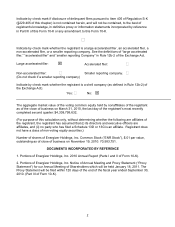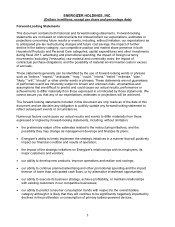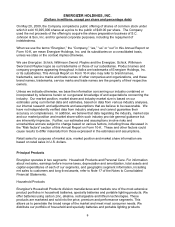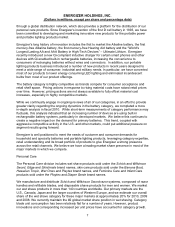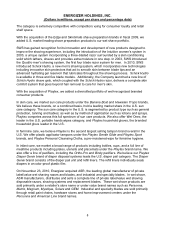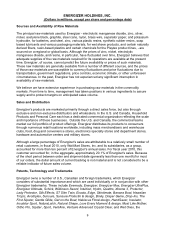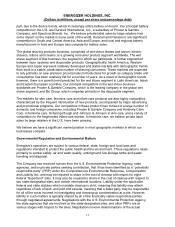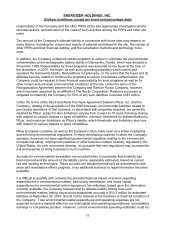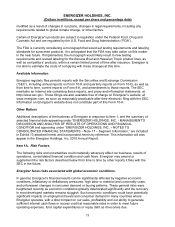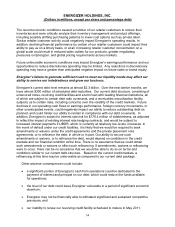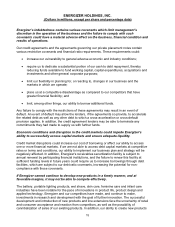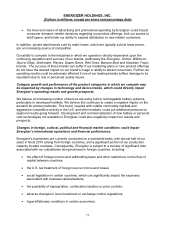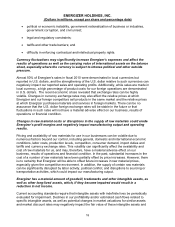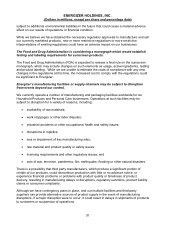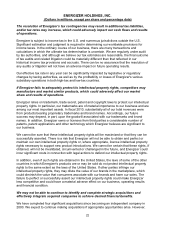Energizer 2010 Annual Report Download - page 22
Download and view the complete annual report
Please find page 22 of the 2010 Energizer annual report below. You can navigate through the pages in the report by either clicking on the pages listed below, or by using the keyword search tool below to find specific information within the annual report.
ENERGIZER HOLDINGS, INC.
(Dollars in millions, except per share and percentage data)
12
responsibility of the Company and the other PRPs at the site, appropriate investigatory and/or
remedial actions, and allocation of the costs of such activities among the PRPs and other site
users.
The amount of the Company’s ultimate liability in connection with those sites may depend on
many factors, including the volume and toxicity of material contributed to the site, the number of
other PRPs and their financial viability, and the remediation methods and technology to be
used.
In addition, the Company undertook certain programs to reduce or eliminate the environmental
contamination at the rechargeable battery facility in Gainesville, Florida, which was divested in
November 1999. Responsibility for those programs was assumed by the buyer at the time of
the divestiture. In 2001, the buyer, as well as its operating subsidiary which owned and
operated the Gainesville facility, filed petitions in bankruptcy. In the event that the buyer and its
affiliates become unable to continue the programs to reduce or eliminate contamination, the
Company could be required to bear financial responsibility for such programs as well as for
other known and unknown environmental conditions at the site. Under the terms of the
Reorganization Agreement between the Company and Ralston Purina Company, however,
which has been assumed by an affiliate of The Nestle Corporation, Ralston’s successor is
obligated to indemnify the Company for 50% of any such liabilities in excess of $3 million.
Under the terms of the Stock and Asset Purchase Agreement between Pfizer, Inc. and the
Company, relating to the acquisition of the SWS business, environmental liabilities related to
pre-closing operations of that business, or associated with properties acquired, are generally
retained by Pfizer, subject to time limitations varying from 2 years to 10 years following closing
with respect to various classes or types of liabilities, minimum thresholds for indemnification by
Pfizer, and maximum limitations on Pfizer’s liability, which thresholds and limitations also vary
with respect to various classes or types of liabilities.
Many European countries, as well as the European Union, have been very active in adopting
and enforcing environmental regulations. In many developing countries in which the Company
operates, there has not been significant governmental regulation relating to the environment,
occupational safety, employment practices or other business matters routinely regulated in the
United States. As such economies develop, it is possible that new regulations may increase the
risk and expense of doing business in such countries.
Accruals for environmental remediation are recorded when it is probable that a liability has
been incurred and the amount of the liability can be reasonably estimated, based on current
law and existing technologies. These accruals are adjusted periodically as assessments take
place and remediation efforts progress, or as additional technical or legal information becomes
available.
It is difficult to quantify with certainty the potential financial impact of actions regarding
expenditures for environmental matters, particularly remediation, and future capital
expenditures for environmental control equipment. Nevertheless, based upon the information
currently available, the Company believes that its ultimate liability arising from such
environmental matters, taking into account established accruals of $10.2 million for estimated
liabilities at September 30, 2010, should not be material to the business or financial condition of
the Company. Total environmental capital expenditures and operating expenses are not
expected to have a material effect on our total capital and operating expenditures, consolidated
earnings or competitive position. However, current environmental spending estimates could be


